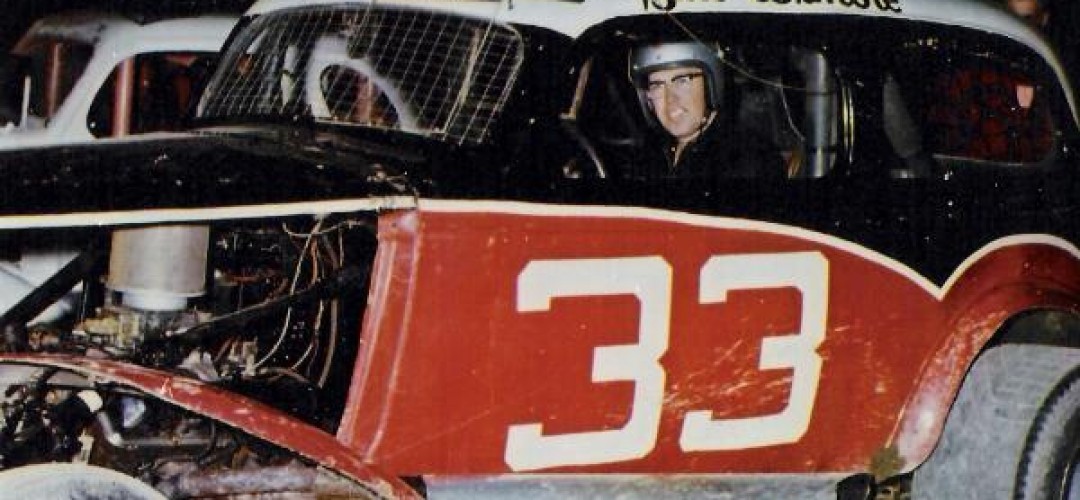Bill Wimble Left an Unfillable Void When He Retired from Racing; Now with His Passing, Another Integral Part of Racing History is gone for Good
Story By: MATT NOLES / RACERSGUIDE.COM Photos By: DAVE DALESANDRO COLLECTION / RACERSGUIDE.COM
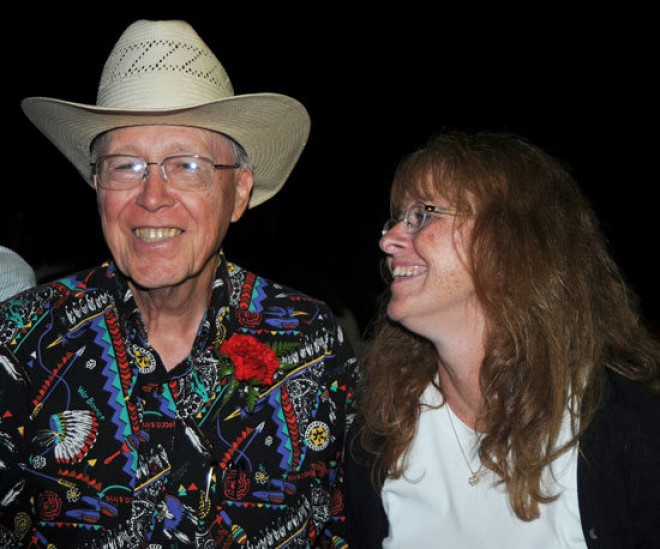 SPRAKERS, NY- May 20, 2016- It was just another sunny Saturday afternoon in Fonda, New York. The traffic strolled by the Winner’s Circle restaurant at its typical lackadaisical pace as the speedway across the railroad tracks slowly began to show signs of life in anticipation of the spectacle to come.
SPRAKERS, NY- May 20, 2016- It was just another sunny Saturday afternoon in Fonda, New York. The traffic strolled by the Winner’s Circle restaurant at its typical lackadaisical pace as the speedway across the railroad tracks slowly began to show signs of life in anticipation of the spectacle to come.
A man with a white hat, tropical patterned shirt and khaki pants eased his way through the double doors and into the venerable racing museum housed around the bar. After a brief nod and courteous hello, this man from a former era did nothing more than to gaze in silence at the photos from the past which adorned every possible space throughout the room. After a few minutes, he smiled, tipped his hat and as quick as he had entered, he was gone.
Bill Wimble never seemed like a 1950s modified driver; at least not what one would expect him to emulate. Soft spoken, tall, wiry and with a personality that seemed more of a gentleman than a giant, Wimble was everything some drivers of the day were not. He quickly proved how looks can be most deceiving.
![B[1]_%20Wimble](http://racersguide.com/wp-content/uploads/2016/04/B1_20Wimble-660x450.jpg) After growing up and racing in an area so far north of Fonda, New York that even the locals considered him a Yankee, Wimble decided to bring his talents to the NASCAR sanctioned ‘Track of Champions.’ It was a decision that would both make the man, and yet in a way, become his undoing.
After growing up and racing in an area so far north of Fonda, New York that even the locals considered him a Yankee, Wimble decided to bring his talents to the NASCAR sanctioned ‘Track of Champions.’ It was a decision that would both make the man, and yet in a way, become his undoing.
Though success came in spurts throughout his early tenure at the historic oval, it wasn’t until the end of the 1958 season that Wimble found not only his stride, but a team that would make him a legend. It was August 23rd of that year when the Lisbon, New York native first climbed behind the wheel of the famous Dave McCredy No. S-33.
In the years that followed, success ran rampant for Wimble. He wasn’t just a local favorite at Fonda, though he fit in with the blue collar farming crowd that attended the speedway in earnest, but he had garnered national fame as well. Aside from winning the 1960 track title at the Montgomery County oval, an accomplishment he would attain a total of five times in his career, Wimble also earned the State and National NASCAR sportsman titles that year; a feat which he would repeat again in 1961.
Wimble’s rise to prominence wasn’t just limited to the national level; his local fame is something of legend around the eastern New York region. In fact, he’s the only driver in history to win a track title at both the Fonda Speedway and the Lebanon Valley Speedway in consecutive years, with the same team and in the same car. Tremont, Hearn, Lazzaro and Jack Johnson can’t post that triumph on their resume and to be truthful, nobody probably ever will. Wimble stands alone in that respect.
From Fonda to Middletown, Lebanon Valley to Stafford Springs, Wimble was a force to be dealt with on a weekly and yearly basis. It seemed that the sky was the limit and his winning ways knew no bounds. Then a nearly-fatal accident in 1968 put a sudden and resolute stop to his racing dominance and, to the disbelief of many, his racing career.
After packing up and leaving Fonda for good at the end of the 1967 season, thanks in large part to the often flamboyant and unbearable Rene Charland, Wimble decided to set down his racing roots on the high-banks of the Lebanon Valley Speedway in West Lebanon, New York; a decision that sat precariously on the edge of anger by many of the Valley faithful.
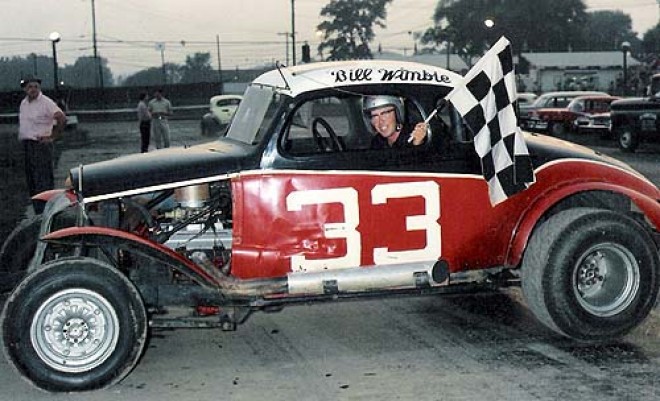 For years, and even in recent times, drivers like Wimble were able to saunter away from Fonda and invade the Valley with ease. In fact, Wimble had proven this true numerous times before. For the well-known No. S-33 to become a permanent sight in the infield brought dread to many competitors and discontent from the stands in rapid and simultaneous outbursts. Their feelings were well warranted as Bill Wimble clinched the point title with nearly a month to go in the season. Needless to say, he wasn’t voted as the Valley’s most popular driver.
For years, and even in recent times, drivers like Wimble were able to saunter away from Fonda and invade the Valley with ease. In fact, Wimble had proven this true numerous times before. For the well-known No. S-33 to become a permanent sight in the infield brought dread to many competitors and discontent from the stands in rapid and simultaneous outbursts. Their feelings were well warranted as Bill Wimble clinched the point title with nearly a month to go in the season. Needless to say, he wasn’t voted as the Valley’s most popular driver.
With the title already locked up and the proverbial key thrown away, Wimble should have been celebrating his triumph as the year wound down. For all that’s known, he was; until August 24, 1968.
As the night’s feature event was coming to a close, Wimble found himself amid an oil slick along the endless backstretch of Lebanon Valley. Every driver was able to miss his disabled racer but one; Joe Messina. The end result was a badly fractured skull and a long stay in the hospital. Though Wimble would recover from his injuries, his racing career would not and after 17 years behind the wheel, he hung up his helmet for the final time; almost.
Though his years as a driver were undoubtedly impressive, it wasn’t just his reputation behind the wheel that made Wimble special, it was his influence away from the cockpit that helped to develop the next generation of drivers. Simply enough, if he hadn’t taken the time to coach some of the up-and-coming drivers of his day, many racing careers weren’t likely to have occurred.
“He had quite of bit of influence on my career really,” stated former modified driver Dave Lape. “I had the chance to ride with him to Victoria Speedway quite a few times and hang out with him for the night and that was a big part of me liking racing and wanting to get into it.”
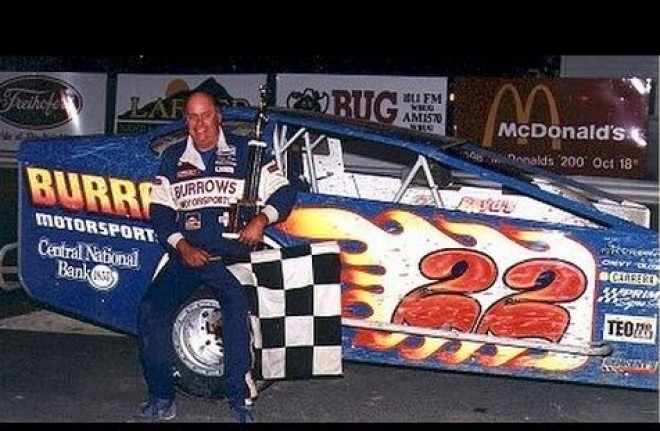 Lape spent 50-years behind the wheel of center-steer dirt modifieds and the lessons that Wimble taught him in those brief and formative moments stuck with him for the entirety of his career; though not necessarily at first.
Lape spent 50-years behind the wheel of center-steer dirt modifieds and the lessons that Wimble taught him in those brief and formative moments stuck with him for the entirety of his career; though not necessarily at first.
“He taught me a lot but I didn’t really pay attention so much when I was young and foolish,” Lape said with a chuckle. “But later on I thought about how he conducted himself and how he treated people. He was always gracious and took time with people as he did with me way back when. It was quite an influence on me, that’s for sure.”
Few people ever have the chance to race with and against their mentors. Even less people have the chance to learn lessons on the track as well as off of it; Lape was one of those more fortunate when it came to racing and learning from Wimble.
“There was one night up at Malta and I guess I got in his [Wimble’s] way,” continued Lape. “I was a lap car and instead of getting upset with me, he talked to me and took the time to teach me the right way and the wrong way of how to conduct myself on the track. When that lesson was done, he said jokingly that I needed a racing name; he called me ‘Dangerous Dave’ and I didn’t realize how true that was until later on.”
As the years passed by, Wimble continued to stay involved in racing in one aspect or another. In short, he was one of the greatest ambassadors the sport had ever known and his contributions have only bolstered his legacy by leaps and bounds. Though his racing career ended in 1968, Wimble made a surprising comeback in 1993 for one race. After helping Dave Lape get his career going 30-years prior, it was time for the great ambassador to get back behind the wheel and time for the student to repay the teacher.
When Andy Fusco and Lape started their wildly successful LAPCO Promotions shows, it was only a matter of time before the duo thought up a way to honor the veterans of the past. When the annual event invaded the Can-Am Motorsports Park in La Fargeville, New York, a tiny hamlet close enough to the border one could almost lob a snowball into Canada, Lape and Fusco brought a few friends with them to share in the night’s festivities.
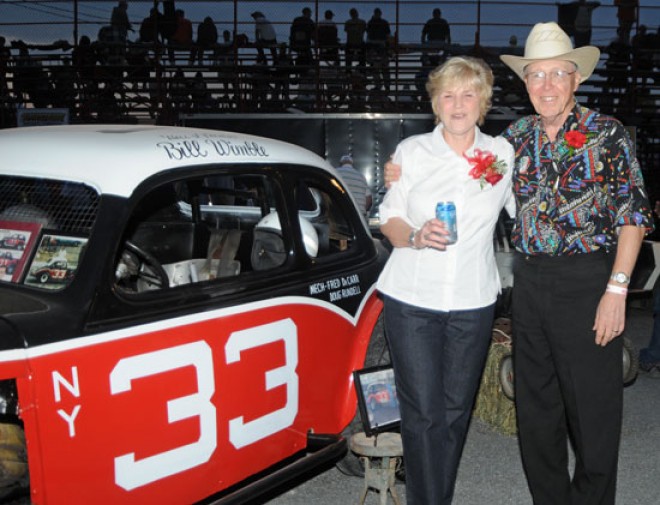 “Well, Andy [Fusco] and I had this great idea that we were going to let Bill pace the field,” continued Lape. “And that was the story we told everybody including Bill’s wife, Nancy.” Nancy Wimble, who stood by in horror during the aftermath of Wimble’s near-fatal wreck years before, never wanted to see her husband back behind the wheel again. He respected her wishes except for this one fateful evening in 1993.
“Well, Andy [Fusco] and I had this great idea that we were going to let Bill pace the field,” continued Lape. “And that was the story we told everybody including Bill’s wife, Nancy.” Nancy Wimble, who stood by in horror during the aftermath of Wimble’s near-fatal wreck years before, never wanted to see her husband back behind the wheel again. He respected her wishes except for this one fateful evening in 1993.
“We ended up having a field of about six or seven old timers that night,” Lape said. “We had Bud Ward, Carl ‘Fuzzy’ VanHorn, Andy Romano and others and so Andy gets the idea in his head about halfway through the show to put on a little race.” It was soon to become one of the most memorable moments of both Dave Lape and Andy Fusco’s lives.
“We were going to send the older guys out there and just ride around,” Lape said laughing. “Well, when it came down to the last lap in the fourth turn, here’s Wimble getting on the gas; rooster tails of dirt flying everywhere. I guess the race car driver in him came back out of hiding for a few minutes there.” The smile on Wimble’s face in victory lane could only be matched by that of Lape and Fusco; it quickly became a cherished memory for all involved.
“Bill Wimble won the last race he was ever in,” said Lape. “We cherished that memory but his wife Nancy didn’t think too much of it at the time. I guess the race driver took over for one last night. It was quite a deal and quite a memory for me and Andy.” To this day, that victory lane photo holds a special place of honor in the Lape household especially now that Lape is the only surviving member of that trio.
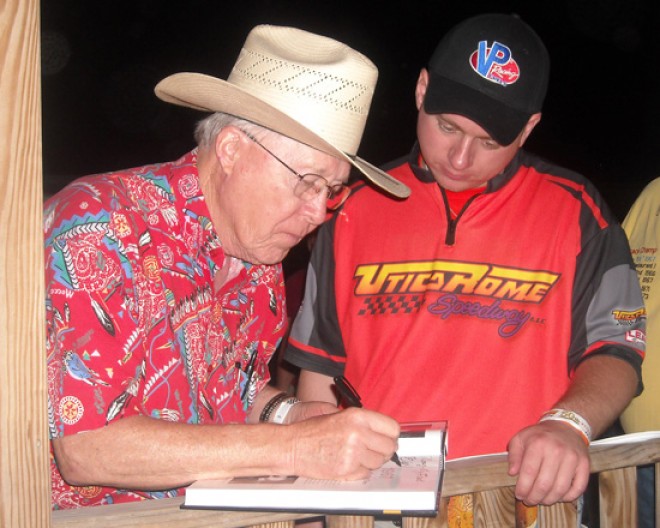 It’s safe to say that Bill Wimble led a full and incredible life both on the speedway and off. Never in a million years would someone have thought any of this was possible. From a small town cow poke to a NASCAR National Champion, from a near-fatal racing incident to a successful businessman and everything in between, Wimble did it all with equal parts grace and determination. A life well lived doesn’t even come close to describing his 84-years of life on this earth. The only thing he loved more in this life aside from his family was the sport of racing and the evidence of his involvement supports that statement tenfold.
It’s safe to say that Bill Wimble led a full and incredible life both on the speedway and off. Never in a million years would someone have thought any of this was possible. From a small town cow poke to a NASCAR National Champion, from a near-fatal racing incident to a successful businessman and everything in between, Wimble did it all with equal parts grace and determination. A life well lived doesn’t even come close to describing his 84-years of life on this earth. The only thing he loved more in this life aside from his family was the sport of racing and the evidence of his involvement supports that statement tenfold.
“Bill was just a real ambassador of the sport,” concluded Lape. “He didn’t just walk away when his driving days were done. He tried to keep memories alive, he tried to keep people involved and even though he wasn’t racing anymore, he was still one of the greatest friends the sport of racing ever had. Period.”
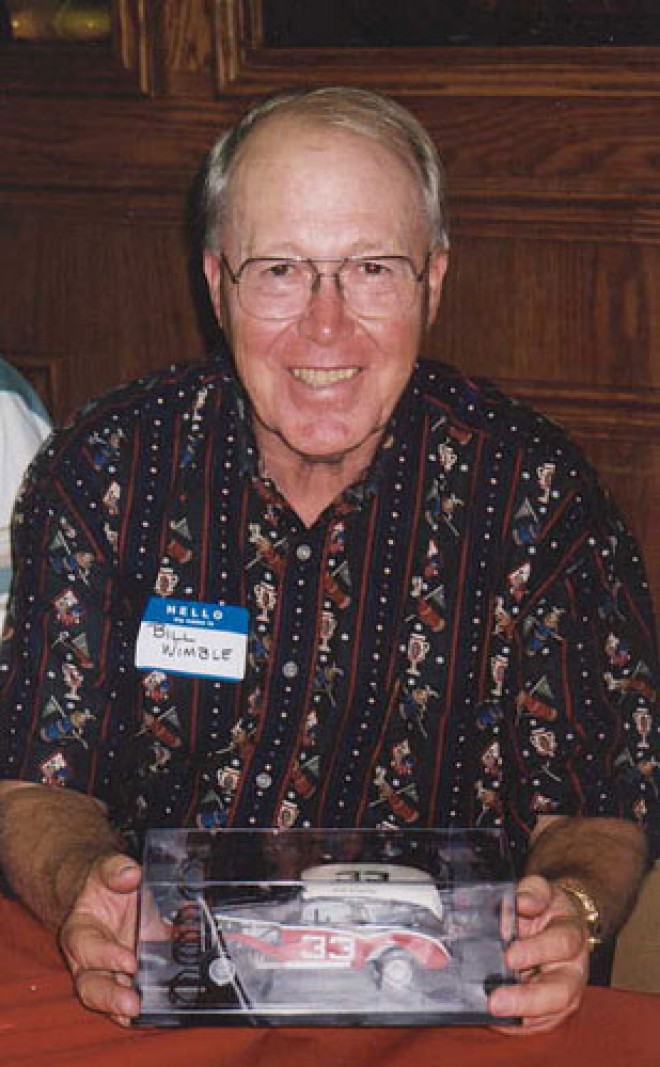 To paraphrase F. Scott Fitzgerald, we will continue on without Bill Wimble, boats beating against the current, borne back ceaselessly into the past. We’ll return to the speedway week after week and year after year. We’ll continue onward with our constant pursuit of grip and endless search for perfection but every now and then we’ll look over our shoulder; back to a time that once was and we’ll remember men like Bill Wimble for the simple fact that we’ll be damned if we don’t.
To paraphrase F. Scott Fitzgerald, we will continue on without Bill Wimble, boats beating against the current, borne back ceaselessly into the past. We’ll return to the speedway week after week and year after year. We’ll continue onward with our constant pursuit of grip and endless search for perfection but every now and then we’ll look over our shoulder; back to a time that once was and we’ll remember men like Bill Wimble for the simple fact that we’ll be damned if we don’t.
It was just another sunny Saturday afternoon in Fonda, New York. The traffic strolled by the Winner’s Circle restaurant at its typical lackadaisical pace as the speedway across the railroad tracks slowly began to show signs of life in anticipation of the spectacle to come.
A man with a white hat, tropical patterned shirt and khaki pants eased his way through the double doors and into the venerable racing museum housed around the bar. After a brief nod and courteous hello, this man from a former era did nothing more than to gaze in silence at the photos from the past which adorned every possible space throughout the room. After a few minutes, he smiled, tipped his hat and as quick as he had entered, he was gone.
Matt Noles is a contributing writer for Racer’s Guide and Speedway Illustrated. He currently resides in Sprakers, New York.

